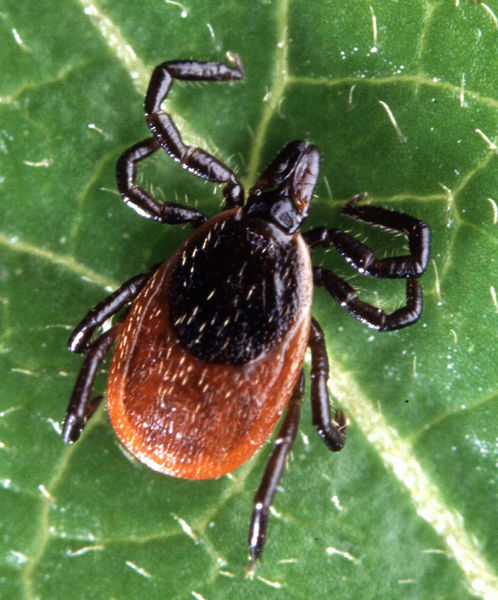Insect and tick diseases on the rise in New York

This unengorged adult deer tick is less than a quarter-inch in length. Provided photo — Scott Bauer, Wikimedia
The federal government recently released a report that says tick- and insect-spread diseases are on the rise, and New York is at the top of the heap in terms of the number of cases.
The Centers for Disease Control said in its “Illnesses on the Rise” report that New York was in the top 20 percent of all U.S. states and territories when it came to occurrences of tick and mosquito pathogens.
The CDC found that from 2004 to 2016, New York had 7,167 reports of mosquito-spread diseases, such as the West Nile virus. In that same time, the Empire State saw 69,313 cases of tick-related issues, such as Lyme disease and powassan virus.
The growth of these diseases is part of a larger trend, with the CDC noting that over those 12 years, vector-borne diseases (from ticks, mosquitoes and fleas) have just about tripled – from 27,388 cases in 2004 to 96,075 cases in 2016. The CDC also says that seven new tick-borne germs that can affect people were found during the same time period.
And while the numbers are stunning, the CDC says that a lack of preparedness and ease of travel will only exacerbate the problem.
“State and local health departments and vector control organizations are the nation’s main defense against this increasing threat,” the CDC wrote. “Yet, 84 percent of local vector control organizations lack at least 1 of 5 core vector control competencies. Better control of mosquitoes and ticks is needed to protect people from these costly and deadly diseases.”
The CDC said in the report that the U.S. is unprepared to handle this rising threat even as the CDC itself is facing serious budget cuts under the Trump administration. The New York Times reported about a year ago that to offset an increase in military spending, the CDC would face a 17 percent budget cut.
“Recent outbreaks of Zika, chikungunya and West Nile viruses and the steady increase in Lyme disease cases point to the need for state and local agencies to have comprehensive vector-borne disease prevention and control programs,” the CDC said in its report. “The US needs better tools and more staff with greater expertise at local and state levels to reduce the growing threat of these diseases in the US.”
According to a report issued in 2016 by the federal Environmental Protection Agency, climate change is a leading driver of the increase of vector-borne diseases.
The EPA says that 20,000 to 30,000 cases of Lyme disease are being reported each year, but the number of actual cases is likely higher.
While noting that climate is not the only factor affecting the spread of ticks which carry Lyme disease, the EPA wrote “studies provide evidence that climate change has contributed to the expanded range of ticks, increasing the potential risk of Lyme disease, such as in areas of Canada where the ticks were previously unable to survive.
“Warming temperatures associated with climate change are projected to increase the range of suitable tick habitat and are therefore one of multiple factors driving the observed spread of Lyme disease,” the EPA said. “Because tick activity depends on temperatures being above a certain minimum, shorter winters could also extend the period when ticks are active each year, increasing the time that humans could be exposed to Lyme disease.”
Climate change – sometimes called global warming – has increased the overall temperature of the planet. But it also results in more extreme temperatures and weather in general. The Adirondacks’ early deep freeze in December and January gave hope to some that the extreme cold would help kill off the exploding tick population.
Richard Gast, with the Cornell Cooperative Extension, wrote in the Adirondack Almanack earlier this year that the below-zero cold would likely have little effect on ticks.
“Extremely cold temperatures do have an impact on overwintering insects and insect-like critters (technically, ticks are not insects. They’re arachnids, like spiders),” Gast wrote. “Some ticks survive as eggs deposited before winter. Depending on the species, a single female tick may lay 3,000-8,000 eggs, after which she dies. Ticks in other stages of development also overwinter in the shelter and relative comfort of the soil or within leaf litter and ground clutter, where snow cover can actually provide additional protection from extremely cold temperatures and wind.
“Even when the air temperature lingers in the double digits below zero, things that are covered with an insulating blanket of snow will remain much nearer to 32F. In fact, the temperature beneath the snow, in many cases, will keep the soil from freezing. And many experts believe that, even without snow, it takes a long period of bitterly cold weather to even have a chance of knocking tick populations back.
“But determining mortality rates based on winter weather conditions is anything but certain. The mechanisms that allow their survival are varied and complicated.”
Gast goes on to say write that in addition to probably surviving the cold, ticks can also overwinter on deer, moose and bear, meaning that even if conditions were perfect for ticks to be killed by weather, the arachnids would be far from disappearing.
The New York State Department of Health says people should take steps to prevent tick bites by avoiding areas where ticks reside, such as in tall grass and brush. Hikers should try and stay in the middle of the trail and anyone who spends time outside should give themselves a thorough search for ticks.






